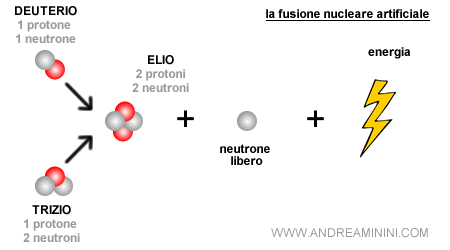Aneutronic fusion: the trouble-free fusion of radioactive waste

One of the incompletely solved problems of nuclear fusion is the emission of neutrons in the case of deuterium and tritium fusions. The two isotopes of hydrogen, when they merge, obtain not only an atom of helium and energy, but also the emission of a neutron.
This energetic neutron is a big problem because it requires strong shielding and therefore can make the metals that make up the reactor structure radioactive, requiring disposal. However, there is not only deuterium-tritium fusion: there are also forms of fusion that do not involve the emission of neutrons, i.e. "Aneutronic fusion".
Aneutronic nuclear fusion is a type of nuclear fusion in which most of the energy released is carried by charged particles, such as protons or alpha particles, and not by neutrons. This has the advantage of reducing problems related to neutron radiation, such as material activation, biological shielding and safety. However, the conditions required to achieve aneutronic fusion are much more difficult to achieve than conventional fusion reactions, such as that between deuterium and tritium.
There are different cases of aneutronic fusion, depending on the nuclei that fuse with each other. Some of the most studied reactions are:
- Deuterium – Helium-3: 2 D + 3 He → 4 He + 1 p + 18.3 MeV
- Deuterium – Lithium-6: 2 D + 6 Li → 2 4 He + 22.4 MeV
- Proton – Lithium-6: 1p + 6 Li → 4 He + 3 He + 4.0 MeV
- Helium-3 – Lithium-6: 3 He + 6 Li → 2 4 He + 1 p + 16.9 MeV
- Helium-3 – Helium-3: 3 He + 3 He → 4 He + 2 1p + 12.86 MeV
- Proton – Lithium-7: 1 p + 7 Li → 2 4 He + 17.2 MeV
- Proton – Boron-11: 1p + 11 B → 3 4 He + 8.7 MeV
The energy emitted by these reactions depends on the difference in mass between the initial and final nuclei. The greater this difference, the greater the energy released. For example, the reaction between deuterium and lithium-6 emits about twice the energy of the reaction between helium-3 and helium-3.
Who is working on this project
Some companies are trying to achieve aneutronic fusion with different methods and fuels. For example, Tri Alpha Energy, Inc. is experimenting with a collective beam fusion reactor (CBFR) that collides two compact plasma toroids in the field-reversing configuration. The fuel used is a mixture of deuterium and helium-3, which gives rise to protons and helium-4 as products of the reaction.
Another example is Helion Energy , which is developing a magnetized fusion reactor (MFR) that uses a combination of deuterium and lithium-6 as fuel. This reaction produces two helium-4 nuclei and releases a large amount of energy.
Both of these companies aim to convert the energy of charged particles directly into electricity, without going through the steam cycle.

Thanks to our Telegram channel you can stay updated on the publication of new articles from Economic Scenarios.
The article Aneutronic fusion: the trouble-free fusion of radioactive waste comes from Scenari Economici .
This is a machine translation of a post published on Scenari Economici at the URL https://scenarieconomici.it/fusione-aneutronica/ on Sun, 23 Jul 2023 14:00:44 +0000.

